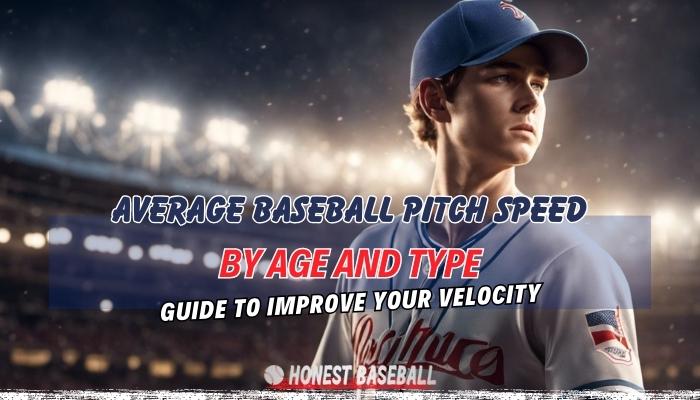The average baseball pitch speed of a fastball (thrown by an MLB pitcher) ranges from 92-93 miles per hour (148-149 kilometers per hour). Even some pitchers already reached speeds up to 100 mph or more.
“That doesn’t mean you’ve to achieve the milestone as a high school pitcher or during the college league. Each stage has a different standard.”
Furthermore, different pitch types, such as cutters, sliders, screwballs, and sinkers, each have their own unique speeds and movements that keep batters on their toes. For different types of styles, the pitching speed can range from as low as 35 mph to as high as 98 mph.
To improve your pitching velocity, you do need to work on mechanics, physical fitness, and mental focus the most. Additionally, body weight and muscle mass can contribute.
In this insightful article, I’m gonna share details about the latest pitch speed statistics – analyzing averages according to age groups, different types of pitches, and what influences velocity.
Average Baseball Pitch Speed by Player Age and Level
Baseball pitch speeds vary by age, with youth league players typically throwing at slower speeds compared to high school, college, and professional players.
Youth Leagues Players: 40-50 mph
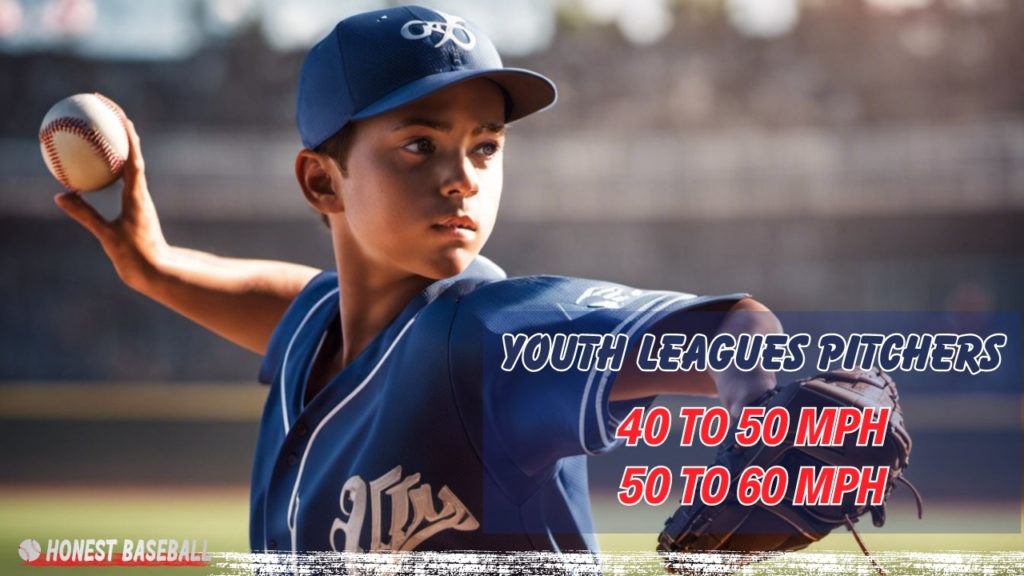
In youth leagues, the average velocity of pitching is relatively slower compared to the maximum perceived velocity of high school, college, and professional players. This applies to players who are typically between 9 and 12 years old.
Usually, in youth leagues, the average velocity of younger players throwing the ball is around 40 to 50 mph.
As they progress in the Majors division, their perceived velocity increases with fastballs reaching speeds, ranging from 50 to 60 miles per hour, which is the maximum standard.
“It’s worth noting that as players get older their pitching speed tends to increase. For instance, ten-year-olds usually pitch at around a rate of 47 mph while eleven-year-olds can reach up to 52 mph on average.”
So, never lose hope!
High School Leagues Players: 65-75 mph
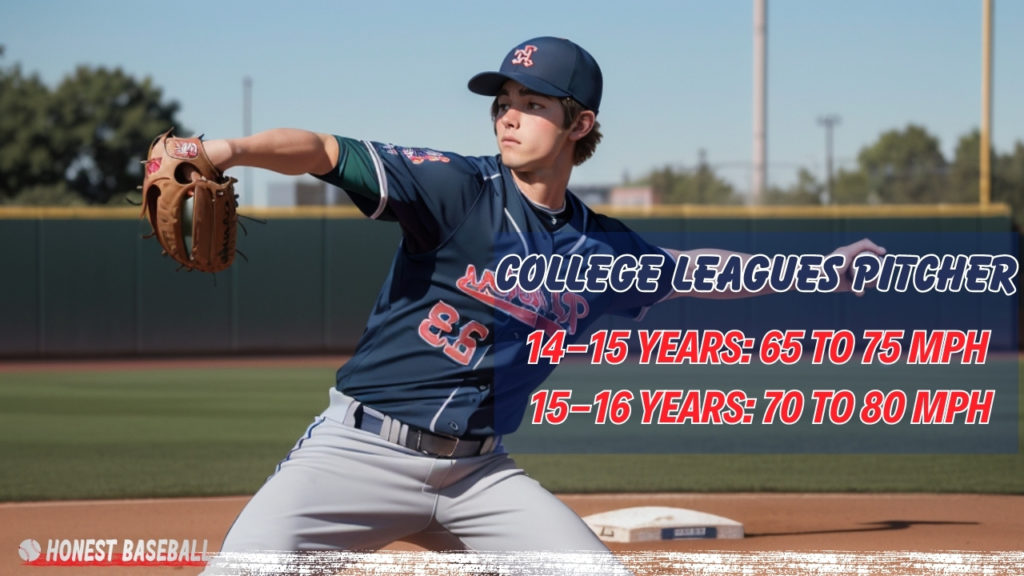
Based on my experience with a group of high school baseball players, the average pitch speed showed a significant increase, including the maximum speed reached.
Freshmen, aged 14-15 years old, usually throw balls at average velocities from 65 to 75 mph. Again as mentioned, as they get older and grow stronger, their perceived velocity gets even faster.
Sophomores, who are around 15-16 years old, average about 70 to 80 mph.
For some high school pitchers hurling balls as fast as 84 mph is not rare! But it’s important to be careful because pitches over the range of 80-85 mph can sometimes cause injury if not consistent with the pitching drills.
“Seniors often have an average baseball pitch speed in the range of the ’60s’ mph.”
College Leagues Players: 85-75 mph
Many college league players show great pitch speeds. Players in the NCAA Division can often pitch at a maximum speed between 85 to 95 mph.
But keep in mind that not all college players have the same perceived velocity or maximum speed. Those from “Division III” may have an average pitch speed of around 77 to 82 mph.
This shows that there is a wide range of abilities even at the college level in terms of maximum speed and average pitch speed. Both these groups work hard and train well to improve their game, which is clear in these impressive numbers.
MLB Professional Players: 92-93 mph
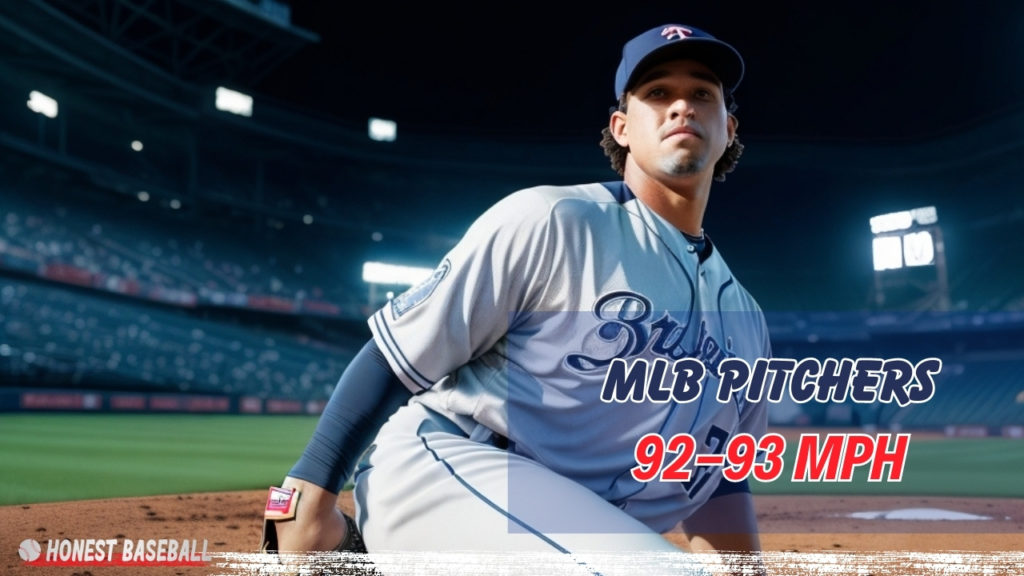
It’s needless to mention that MLB professional players have the highest average pitch speeds in baseball.
They can throw faster than 90 miles per hour (mph). No wonder, this is because they are highly trained athletes with advanced skills and physical conditioning, which allows them to achieve impressive average pitch speeds.
“If you consider the last 5 years of statistics, the average pitching speed by the MLB players is 92-93 miles per hour, which is higher than any league.”
In fact, the average fastball velocity in MLB has been increasing over the years, from 93.1 mph in 2015 to 93.9 mph in 2022. These players are at the top of their game.
That’s what in a nutshell, the average throwing speed by age and different levels. Let’s take a quick look at the recent Major League Baseball statistics.
MLB Pitchers’ Pitching Speed Statistics 2023 Report
The 2023 MLB season saw some impressive pitch speeds with Jhoan Duran holding the record for the fastest pitch of the year. Here is a detailed report on the MLB players’ pitching speed statistics for 2023:
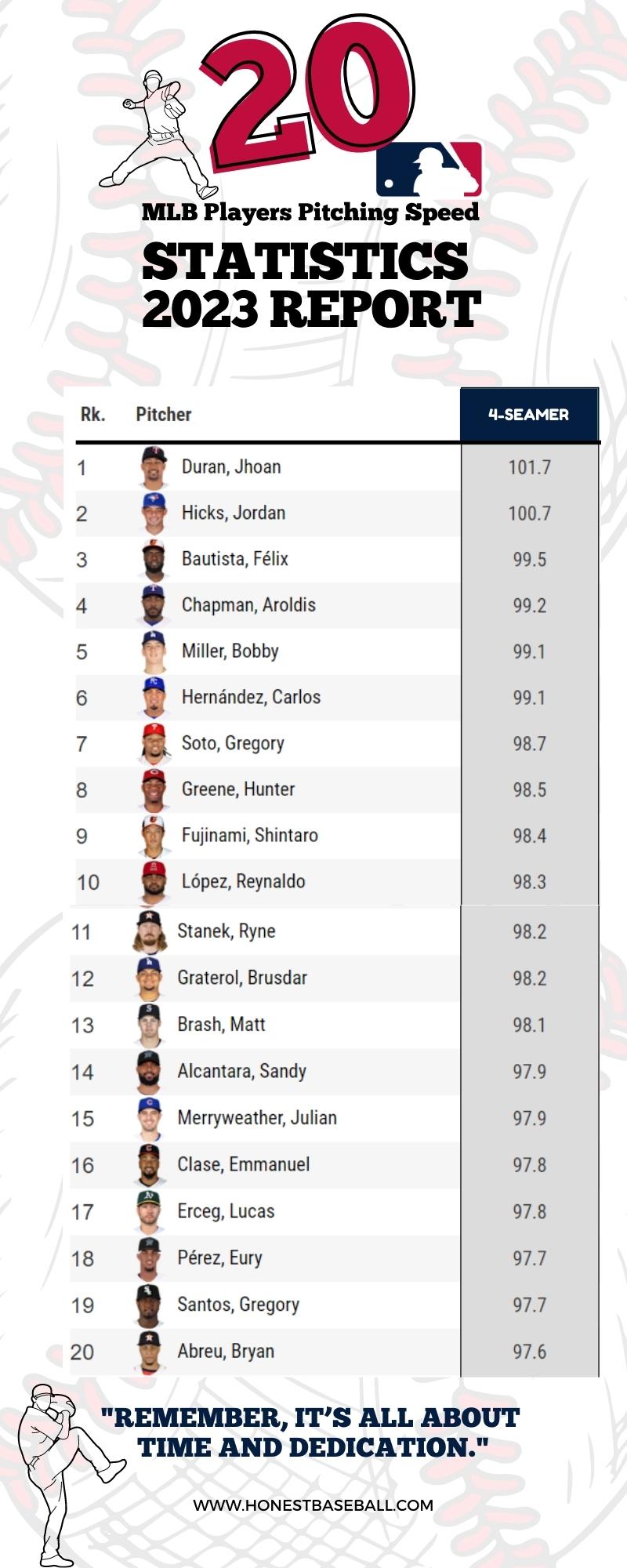
“Interestingly, Duran’s pitch was the 11th fastest since pitch tracking began in 2008, just behind Aroldis Chapman’s record pitch of 105.8 mph. “
BTW, This year, there were numerous changes in the MLB including the introduction of a new pitch clock and implementation of rule changes that impacted the game’s dynamics.
Average Baseball Pitch Speed for Different Pitch Types
Yuppy, it’s not only for age groups but also for the type of pitch, you’ll see significant ups and downs in speeds or velocities.
And when it comes to baseball players, they can throw numerous ways (at least 14). Some of the best baseball pitches to throw are changeups, fastballs, curveballs, cutters, and sliders.
Let’s take a detailed look at them and their impacts on pitching velocity.
1. Changeup (CH): 75-85 mph
The changeup is a sneaky pitch in baseball. So what makes it so tricky? Well, batters often get fooled when the pitcher takes some off and throws a changeup.
Their timing gets all messed up! They swing too early or they get jammed as the ball tails and sinks. A good changeup can make great hitters look silly.
“It’s thrown slower than a fastball, usually between 75-85 mph for pros. For high school players around 13 or 14 years old, the changeup is even slower – from 60-75 mph.”
The speed difference is the key. A pro pitcher’s changeup might be 10-15 mph slower than his fastball. For a 14-year-old hurler, the change could be 15 mph off the fastball. That’s a huge gap!
2. Curveball (CU): 70-80 mph
The curveball pitch really messes with batters’ heads! Though it’s slower than a fastball, it’s the crazy-breaking action that makes it nasty.
“It comes zooming toward the plate around 70-80 mph on average”
When a pitcher throws a good curve, that ball curves hard and drops sharply as it gets to the plate. We’re talking about a big looping arc that dives down at the last second. From a hitter’s perspective, it starts off looking like it’ll be a strike, then – bam! – the bottom drops out and it’s in the dirt.
3. Cutter (FC): 85-90 mph
Now that’s a sneaky fastball that jams up batters. It’s basically a type of fastball that has that late, cutting movement in towards the hands.
“The average speed for a cutter is around 85-90 mph, sometimes a little faster.”
With the newer tech these days, they’re clocking pro cutters even quicker – up to 95 mph or so. But it’s not just about velocity – it’s the way it moves inside on righties and away from lefties at the last second that makes it nasty.
Just when a batter is gearing up to swing at what looks like a normal fastball, the cutter darts in and ties them up. And since it looks so similar to a basic fastball out of the pitcher’s hand, it’s deceptive too. The hitter doesn’t pick up on that late slicing action until it’s too late and they’re jammed!
To add some velocity to your pitches, mastering the cutter can be an effective tool in your arsenal on the mound.
4. Eephus (EP):Eephus (EP): 35-50 mph
Next, we’re looking at a very slow, yet, tricky pitch in baseball. In short, the goal of the eephus pitch is to catch batters off guard with their unique trajectory and slow speed.
“The Eephus threw with a very high arc and at a low velocity, usually between 35 to 50 mph.”
This makes it difficult for them to time their swing correctly. Pitchers use the eephus as a surprise pitch to deceive hitters and get them out.
I suggest mixing things up on the mound and keeping your opponents guessing, give the eephus pitch a try!
5. Forkball (FO): 75-85 mph
Just like the name, forkball is a pretty cool pitch that not a lot of pitchers throw. It’s kind of like a slower changeup that drops really sharply as it gets to the plate. When thrown right, the forkball will dive downwards, fooling the batter completely!
“The average forkball is thrown between 75-85 mph, so it’s slower than a fastball.”
For forkballs, the grip is important – you hold the ball with your fingers spread wide apart like a fork. That’s how it gets its name!
It takes a lot of practice to control a forkball though. You’ve to snap your wrist and fingers just right to get that hard downward break. Throwing it too hard might make it flatten out. But man, if you can get that nice dive as it reaches the plate, the forkball can make hitters look silly. Pretty cool specialty pitch!
If I’m a batter and I think it’s coming in as a strike, but then it plummets down at the last second, it’s really hard to hit! I’ll probably end up swinging over the top of it.
6. Four-seam Fastball (FF): 92-98 mph
One thing all baseball players, including coaches, will agree on is that the four-seam fastball is one of the main pitches almost every pitcher uses these days. Whether they use 2 seams or 4 seams pitching, the four-seam fastball remains a crucial part of a pitcher’s arsenal. It’s basically a straight, super-fast pitch.
“In the pros, the average four-seamer is around 94 mph, but the really fast pitchers can even hit 100 mph!”
Now for us early buds, four-seamers are probably in the 60-75 mph range. Still pretty zippy!
The key is throwing it with good mechanics so it stays straight and rises a bit through the strike zone. Gripping it with your fingers along the seams – that’s where the “four-seam” name comes from.
The four-seamer is all about bringing pure heat! Since it doesn’t have as much movement as other pitches, you’ve just gotta blow it by the batter with velocity. So stay loose, use your legs and core, and really whip that arm.
It takes a lot of practice to control a four-seam fastball at high speeds. But it’s one of the best pitches for challenging hitters.
7. Knuckleball (KN): 60-70 mph (But can vary greatly)
It’s way different than a regular fastball or curveball. The whole point of a knuckleball is to make the baseball move around in weird ways as it approaches the batter.
“Although it’s thrown pretty slow, usually between 60-70 mph. But it’s not about speed – it’s about making the ball dance!”
To throw a knuckleball, you hold the ball with your fingernails instead of your fingertips. And you throw it with no spin so it can float and flutter toward the plate.
8. Knuckle-curve (KC): 70-80 mph
It breaks like a curveball, diving down sharply. But it’s thrown with a knuckleball grip, using your fingernails instead of fingertips. It starts off looking like a normal pitch, then suddenly drops off the table!
“The speed is around 70-80 mph, so it’s slower than a fastball but faster than a knuckleball.”
Batters have a tough time adjusting to the knuckle curve’s movement. It can make hitters swing over the top or flail in the air. Learning to throw this pitch takes work, but it’s a great weapon for fooling batters if you can get it down. Definitely a fun one to try!
9. Screwball (SC): 75-85 mph
A really unique pitch that breaks in the opposite way of other pitches – Yuppy, I’m talking about the screwball. Instead of curving or diving down, it moves up and to the arm side.
“On average, a screwball is tossed at about 75 to 85 mph – not exactly lightning speed, but it comes with a reverse twist.”
When a right-handed pitcher throws a screwball, it moves upwards and towards the right. It’s different from sliders and curves because it goes in the opposite direction.
Screwballs used to be more popular back in the day. But they are harder to control and some pitchers got injured throwing them.
If you can master the movement, the screwball is a great weapon for confusing batters since it moves differently than what they expect
10. Sinker or Two-Seam Fastball(SI): 88-92 mph
The sinker, also called a two-seam fastball, is a great pitch with nice downward movement. What makes the sinker out of the box is that it tails either left or right at the last second. For a righty pitcher, it’ll bore in on a right-handed batter. Against lefties, it sinks away.
“It’s thrown hard, usually between 88-92 mph.”
Remember, sinkers don’t curve as sharply as other pitches. But it’s one of the fastest pitches in a pitcher’s toolbox. And the late sink makes it really challenging for batters to hit solid contact. They end up pounding the ball into the ground a lot!
11. Slider (SL) Going Fastball: 82-86 mph
The slider is a super fun pitch to throw! You should try this if you want to make the ball break down and away from batters.
“It catches nearly the fastball speed ranges, usually between 82-86 mph.”
If you’re a right-handed pitcher trying a slider, you should make sure your pitching moves in a downward and leftward direction, away from a batter (who also hits with their right hand.)
The break shouldn’t be as big as with other pitches like a curveball – more of a quick, snapping movement downwards.
Throwing a good slider takes a lot of practice so you get the hand position and release just right. You don’t want it to spin too much or not enough.
When you nail that sharp, late break, the slider can make batters swing and miss! Add one to your pitching mix if you want a nice off-speed pitch that darts away from hitters.
Check out the difference between a slider and a curveball.
12. Slurve (SV): 80-84 mph
The slurve is one of those pitches that blends different throws together. As you can probably guess from the name, it combines the qualities of both a slider and a curveball.
“It breaks sharply like a curve but has a little more velocity behind it – usually between 80-84 mph.”
For batters, it starts off looking like a fastball but then darts down and to the side right at the last moment!
Since the slurve has that sharp bite of a curve plus some added speed, it can really throw off a hitter’s timing. They have less time to react before it dips out of the zone.
13. Splitter (FS): 75 to 90 mph
Thinking about another sharp dropper? Well, you shouldn’t miss on splitters. It’s known for its big diving movement down through the strike zone.
It starts up high looking like a fastball, then plummets at the last second. Just get your fingers split apart on the seams and snap it hard so it drops off the table.
“The speed can vary, but usually an MLB splitter is between 75-90 mph.”
Some major league pitchers throw nasty splitters even faster, like 91 mph! And other guys are effective with slower ones around 79 mph.
Hitters have trouble adjusting to that late drop. They’ll swing over the top or pound it into the ground.
14. Sweeper (ST): 82.2 mph (2022-2023 stats)
It’s a relatively new addition to MLB’s repertoire of pitches and has gained popularity among pitchers. The sweeper is a bit slower than a traditional slider, allowing it more time to move across the strike zone. It essentially combines the movement of a slider with significant lateral motion.
“The sweeper baseball pitch has an average speed of 82.2 mph, according to the combined statistics from 2022-2023.”
This unique pitch provides an additional option for pitchers looking to deceive batters. You can always bet on sweeping.
10 Factors That Impact Pitching Velocity: Ways to Increase the Speed
So, that was all about stats. Next, I’m gonna share some scientific ways to achieve these pitching speeds. This is more serious than young athletes think.
1. Develop Strength and Power
You gotta be strong if you wanna do better on the mound! Arm strength is huge for pitching velocity and perceived velocity. The more power you can generate, the faster you can whip that ball to the plate.
But don’t overdo it too young and risk potential injury.
And it’s not just your arms – your legs and core are key too. Having muscle all over makes it easier to transfer energy into each pitch. Those long-armed pitchers can really leverage their strength.
Back in the 1920s, average velocity was around 75 mph. Now pro pitchers hit 95-100 mph!
Lifting weights is awesome for velocity training. Do squats and bench presses to build muscle. Just make sure you stretch a ton too so your body stays flexible. Use your hips and momentum to increase speed.
Tall pitchers can leverage their height for more powerful throws.
Developing power takes hard work and smart training. Check your velocity gains by charting speed from radar gun readings. Compare yourself to MLB history stats.
“The equation for power in baseball and strength training is P = Force x Velocity. For elite baseball players, developing strength and power is essential for improving their pitching speed.”
2. Learn Efficient Mechanics
Adapting to smooth mechanics is inevitable. By using proper form, you transfer energy from your legs and core into each pitch. Good technique puts less stress on your arm too, avoiding injury risks.
Work on stuff like posture, balance, driving with your legs, rotating your hips, getting that arm speed fast, and flicking the wrist. Follow pitching volume recommendations for your age group.
It takes practice but clean mechanics equal gas in the tank! Refine your windup and delivery through reps. Staying efficient means you fatigue less and can maintain velocity. Keep improving little by little!
3. Exposure to Throwing Volumes
Throwing a ton can really increase your speed over time! It builds strength and endurance in your pitching muscles. Follow Little League guidelines for pitch counts, rest periods, and precautionary limits. Give your arm time to recover between outings.
Build up throwing volume gradually each year. Listen to your coaches and don’t push past discomfort. Implementing a smart, structured throwing program is the key to gaining velocity while avoiding serious risks!
4. Mobility Gives You Advantages
Being mobile and flexible is so important for pitching velocity! Good mobility means your body can move freely to generate power. Exercises that strengthen your joints and muscles also boost mobility.
Work on improving your range of motion by stretching your shoulders, hips, and core. Rotate and twist to increase movement. Compare your standard with average pitch speed to MLB history.
Follow a smart training program focused on mobility and you’ll be lighting up the radar gun in no time!
5. Get Some Body Weight
Body weight plays a significant role in pitching velocity. Research shows that pitchers with greater body weight tend to throw faster pitches. This is because increased muscle mass, achieved through weight training and consuming enough calories, can contribute to improved velocity.
However, body weight alone isn’t the only factor influencing pitching speed. Consider gaining some body weight while also focusing on other key aspects of your game.
6. Muscle Composition and Fatigue
Muscle composition plays a crucial role in pitching velocity, and fatigue can have a significant impact on performance.
When pitchers throw, their muscles work hard to generate power and speed. However, over time, your muscles become tired and lose strength, resulting in decreased velocity. Additionally, muscle fatigue can affect pitching mechanics, leading to changes in throwing motion and accuracy.
So, what should you do? To become a better baseball pitcher, you need to manage muscle fatigue by allowing for proper rest and recovery between pitching sessions.
And taking care of muscles through good food habits is also important. Such as
- Protein-rich foods: Foods like lean meats (chicken, turkey), fish (salmon, tuna), eggs, and dairy products (milk, yogurt)
- Legumes: Foods such as beans, lentils, and chickpeas are not only high in protein but also contain other important nutrients like fiber and carbohydrates that support muscle development.
- Nuts and seeds: Almonds, walnuts, chia seeds, and flax seeds provide healthy fats along with protein. They are also rich in vitamins and minerals that aid in muscle recovery.
- Greek yogurt: Greek yogurt is a versatile food that packs a good amount of protein while also providing probiotics for gut health.
- Quinoa: This whole grain is a complete protein source containing all the essential amino acids required for muscle synthesis. It also consists of fiber to support digestion.
- Neurological Fatigue Matters
Your brain is the center hub to control all body actions. When the neurological system becomes fatigued, it affects a pitcher’s ability to generate power and control their movements.
What happens next? This leads to decreased pitch speeds and potentially alters pitching mechanics. Also, fatigue in the neurological system may result from overuse, lack of rest time, poor mechanics, or pushing oneself too hard.
Thus, professional baseball players take it pretty seriously. If you’re already experiencing such issues, take steps to manage it through proper rest, recovery, and maintenance of good pitching biomechanics.
7. Intent or Mindset Plays Vital Role
Don’t get confused. Intent actually refers to the mindset and focus that individual pitchers bring to their delivery.
Trust me these are all connected! Having a strong intent can help pitchers generate more power and speed in their pitches. When you’re fully committed and determined to throw hard, you can tap into the full potential.
This means being aggressive with every pitch, giving it your all, and not holding back.
To become a speedy professional baseball pitcher, you need to maintain this level of intent throughout each game and practice session.
With a clear intention in mind, pitchers can learn the pitching sequence strategy, push themselves harder, and strive for continuous improvement. Do these:
● Visualize success
● Develop mental toughness
● Stay committed
● Analyze performances
● Seek feedback
● Embrace failure as an opportunity for growth
● Rest well & stay physically fit
8. Find the Perfect Grip
It may sound easier than done. However, experimenting with various grips on the baseball pitching can have a big impact.
For instance, it helps you achieve a higher spin rate, better control over the ball, and eventually increase your pitch velocity.
Try out different grips and find the one that works best for you, you can improve the way the ball moves through the air and make it more challenging for batters to hit.
Remember, there’s nothing like a concrete plan. So, don’t be afraid to test different grip techniques and see how they affect your pitching performance.
It’s all about finding what works best for you!
9. Utilizing your Entire Body
All the above requires utilizing your entire body. These elements are crucial for generating the force needed to propel the ball with more speed. Approximately 50% of the ball’s velocity during an overhead throw comes from the step and body rotation alone.
To achieve this, focus on maximizing leg drive, hip rotation, torso rotation, shoulder separation, and arm speed.
Add this bonus tip, and hip-shoulder separation improves velocity.
10. Enhancing Wrist Snap
Developing a strong wrist action is crucial for increasing ball speed when pitching. Focus on improving the action of your wrist at the point of release. This way you can generate more power and velocity in your pitches.
How? A solid wrist snap creates a backspin on the ball, adding speed and movement to your pitch.
To enhance this technique, you can try drills like the Flick Drill that specifically target wrist snaps.
How to Measure Pitch Speeds – Calculation Methods
To determine the velocity of a baseball pitch, you can try various technologies and methods. One used method involves radar guns that measure the speed of the ball as it travels through the air. For speed measurements, radar guns need to be positioned behind the pitcher.
My favorite radar guns:
- Bushnell Velocity Speed Gun (Low Price but serves the best)
- Pocket Radar Smart Coach/Compatible with Pocket Radar App (High Price but most powerful)
Another advanced tracking system called PitchF/X utilizes cameras to track and analyze the trajectory and speed of each pitch in time. This cutting-edge technology provides data on the position, velocity, and even movement of the ball in three dimensions.
Furthermore, there are applications that utilize smartphone technology to measure pitch speeds using built-in sensors or video analysis.
Frequently Asked Questions
How does the average throwing speed differ for teens?
Throwing speeds usually go up with age, so a 17-year-old will often throw faster than a 16-year-old.
Is there an average speed of a baseball pitch for a high school player?
Yes, high schools keep track of the average pitching speeds which vary from one student to another based on their skill level.
How fast does an average MLB pitcher throw?
The average MLB pitcher throws a fastball at a speed of around 92-93 miles per hour (148-149 kilometers per hour). However, the speed of different types of pitchers may differ depending on their skill, experience, and physical abilities.
Some pitchers can throw even faster. For example, Nolan Ryan threw at 108.1 mph, which is one of the fastest baseball pitches ever recorded in MLB history.
Is 75 mph fast baseball?
It depends on which age group you’re asking the question. For high school pitchers aged 13-14, the average fastball is 60-75 mph. From ages 15-16, velocity jumps to 70-80 mph typically. Elite high schoolers can even hit 90 mph or more on rare occasions. I think you got your answer.
Can you pitch 100 mph?
Well, though it may sound like impossible, but you can actually pitch at 100 mph. Don’t believe me, believe MLB stats, which show around 10 MLB pitchers catch the 100 mph milestone in every baseball season.
Wrapping Up
Pretty cool to learn about all those stats on average baseball pitch speed, right? Now, you know what heat to expect at your level, and what the pros are chucking in the majors. I’ll just repeat the importance.
Get strong by lifting weights, work on smooth mechanics, make sure you’re gripping the ball just right, use your legs and core power, and get that wrist snapping at the end.
Yeah, it takes a lot of practice, but you can definitely gain velocity if you train smart and stay healthy.
A few more mph each year is a great goal. Just keep at it – throw hard but also stay loose and have fun! Before you know it, you’ll be lighting up the radar gun too, and striking out batters with cheddar!
Check out the essential guide for pitching velocity training:
How To Increase Pitching Velocity By 10 MPH
How to Throw a Baseball Faster?
7 Best Baseball Radar Guns- With Buying Guide

Hello everyone. My name is Jason Butler, and I live in California, America. I was a professional AAA Minor League Baseball player. I lost my chance of playing MLB for injury issues, but I did not lose my love for baseball. I attended the coaching training program and am now working as a coach in a small school in San Diego.
I always love to share my experience and knowledge if that can help you. Play baseball, and stay fit.
